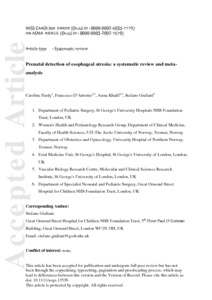Pardy, C; D'Antonio, F; Khalil, A; Giuliani, S
(2019)
Prenatal detection of esophageal atresia: a systematic review and meta-analysis.
Acta Obstet Gynecol Scand, 98 (6).
pp. 689-699.
ISSN 1600-0412
https://doi.org/10.1111/aogs.13536
SGUL Authors: Khalil, Asma
![[img]](https://openaccess.sgul.ac.uk/110612/1.hassmallThumbnailVersion/Pardy_et_al-2019-Acta_Obstetricia_et_Gynecologica_Scandinavica.pdf)  Preview |
|
PDF
Accepted Version
Available under License ["licenses_description_publisher" not defined].
Download (1MB)
| Preview
|
Abstract
Introduction
The primary aim of this systematic review was to quantify the diagnostic performance of ultrasound, magnetic resonance imaging and amniotic fluid analysis in detecting esophageal atresia prenatally. The secondary aim was to explore the accuracy of individual imaging signs in identifying this anomaly.
Material and methods
MEDLINE, Embase and Cochrane databases were searched. The quality of studies was assessed using the revised tool for the quality assessment of diagnostic accuracy studies. Summary estimates of sensitivity, specificity, positive and negative likelihood ratios, and diagnostic odds ratio for the predictive accuracy of ultrasound, magnetic resonance imaging and amniotic fluid analysis in detecting esophageal atresia were computed using the hierarchical summary receiver operating characteristic or DerSimonian‐Laird random‐effect model, according to the number of studies included in each analysis. PROSPERO registration number: CRD42017055828.
Results
Twenty studies (73 246 fetuses, 1760 affected by esophageal atresia) were included. Overall, prenatal ultrasound had a sensitivity of 31.7%. Only two studies reported all data for diagnostic accuracy; based on these studies, prenatal ultrasound had a sensitivity of 41.9%, a specificity of 99.9%, a positive likelihood ratio of 88.1, a negative likelihood ratio of 0.58 and a diagnostic odds ratio of 153.7. Prenatal ultrasound correctly identified 77.9% of cases with esophageal atresia and 21.9% esophageal atresia with an associated tracheo‐esophageal fistula. Polyhydramnios was present in 56.3% of cases affected by esophageal atresia, and a small or absent stomach was identified in 50.0% cases. When performed following a suspicious ultrasound, fetal magnetic resonance imaging had an good overall diagnostic accuracy for esophageal atresia, with a sensitivity of 94.7%, a specificity of 89.3%, a positive likelihood ratio of 8.8, a negative likelihood ratio of 0.06 and a diagnostic odds ratio of 149.3. Finally, amniotic fluid analysis with an esophageal atresia index ≥3 had a sensitivity of 89.9% and a specificity of 99.6% in detecting esophageal atresia.
Conclusions
Ultrasound alone is a poor diagnostic tool for identifying esophageal atresia prenatally, and has a high rate of false positive diagnoses. Magnetic resonance imaging and amniotic fluid analysis have high diagnostic accuracy for esophageal atresia. We would recommend their use following a suspicious ultrasound.
| Item Type: |
Article
|
| Additional Information: |
This is the peer reviewed version of the following article: Pardy, C, D'Antonio, F, Khalil, A, Giuliani, S. Prenatal detection of esophageal atresia: A systematic review and meta‐analysis. Acta Obstet Gynecol Scand. 2019; 98: 689‐ 699, which has been published in final form at https://doi.org/10.1111/aogs.13536. This article may be used for non-commercial purposes in accordance with Wiley Terms and Conditions for Use of Self-Archived Versions. |
| Keywords: |
MRI, amniotic fluid analysis, esophageal atresia, prenatal diagnosis, ultrasound, 1114 Paediatrics And Reproductive Medicine, 1117 Public Health And Health Services, Obstetrics & Reproductive Medicine |
| SGUL Research Institute / Research Centre: |
Academic Structure > Molecular and Clinical Sciences Research Institute (MCS) |
| Journal or Publication Title: |
Acta Obstet Gynecol Scand |
| ISSN: |
1600-0412 |
| Language: |
eng |
| Dates: |
| Date | Event |
|---|
| 14 May 2019 | Published | | 6 March 2019 | Published Online | | 7 January 2019 | Accepted |
|
| Publisher License: |
Publisher's own licence |
| PubMed ID: |
30659586 |
 |
Go to PubMed abstract |
| URI: |
https://openaccess.sgul.ac.uk/id/eprint/110612 |
| Publisher's version: |
https://doi.org/10.1111/aogs.13536 |
Statistics
Item downloaded times since 06 Feb 2019.
Actions (login required)
 |
Edit Item |



